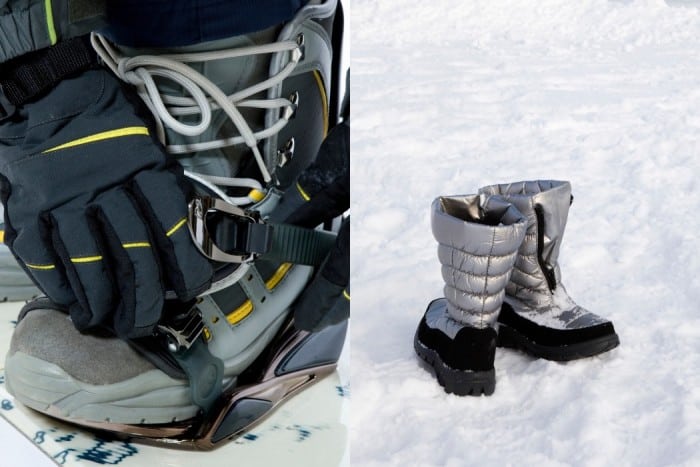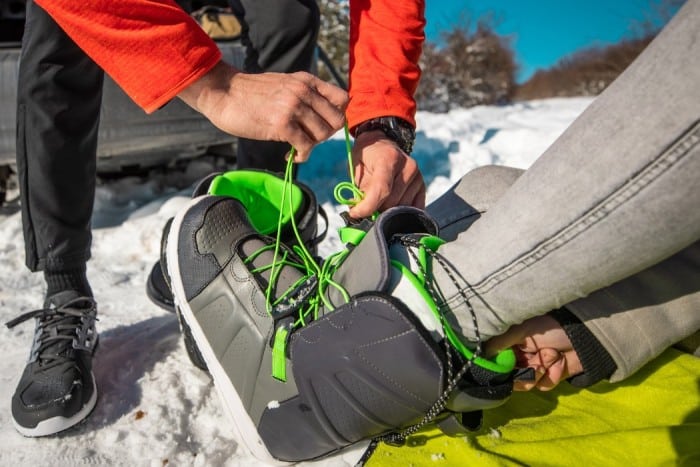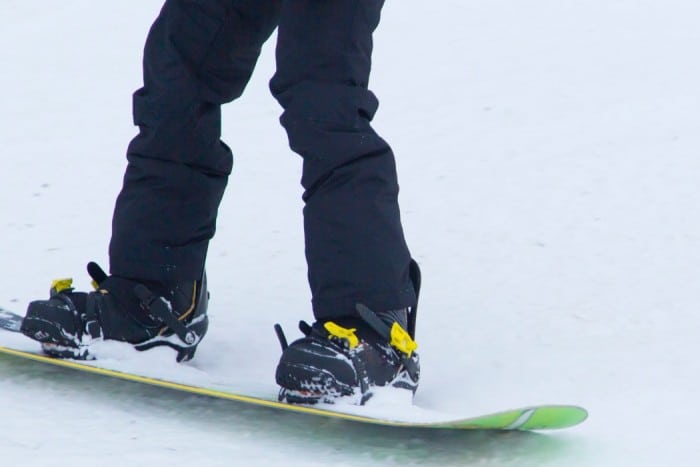At a glance, snowboard boots and snow boots may not appear too dissimilar, and it’s a well-known fact that the former are far more comfortable to walk in than ski boots. However, just because the two share plenty of visual similarities doesn’t necessarily mean they’re made in the same way or for the same purposes.
Aside from short walks between lifts and brief hikes to backcountry lines, snowboard boots aren’t a suitable substitute for snow boots. The stiff soles and robust ankle support make them difficult to walk in and what may begin as a little discomfort may turn into an injury after prolonged use.
Today, we’re going to explore the differences between snowboard boots and snow boots and take a look at why the two aren’t as interchangeable as they may appear.
Are Snowboard Boots And Snow Boots Different?
While they both have the word “snow” in their name, the truth is that aside from being a type of boot, the two styles of footwear have a lot fewer things in common than they share.
Snow boots are effectively a variation of high-top hiking boots designed to be completely waterproof with greater thermal insulation to provide protection from the cold.
They’re also designed to provide more friction on icy surfaces to prevent slips and falls.
They come in various styles, from stylish boots mostly used for short walks through the snow and getting from A to B in mountain resorts to heavy-duty versions better suited for long-distance treks.
On the other hand, snowboard boots are highly technical pieces of gear that have been designed specifically with snowboarding in mind.
They’re also waterproof, insulated, and have grippy soles, but that’s about as far as the similarities go.
On the surface, snowboard boots and snow boots look relatively similar, so it’s not unreasonable to question whether the two are interchangeable; however, they’re much more different than you might expect.

The Differences Between Snowboard Boots And Snow Boots
Now, let’s look at the specific differences (and a few similarities) between snowboard boots and snow boots to get an idea of why it’s not so easy to swap one for the other.
1. Materials & Construction
One key difference you’ll notice when examining a snow boot compared to almost any other type of boot is that the bottom outer section, up to roughly the middle of the ankle, is made entirely of rubber.
Rubber is the go-to material because it’s completely waterproof and doesn’t need to be treated with specialized sprays or coatings. It’s tough, easy to clean, and provides excellent flexibility.
The upper outer section is usually made of leather or a leather-nylon blend for hiking-style boots, although casual versions use a softer polyester-style fabric.
You’ll find a snow-gaiter at the top of the boot, designed to prevent snow from getting into the top.
For snow boots that favor fashion over function, this gaiter may be a type of fur or fleece; however, boots intended for heavy-duty work will normally have a drawstring gaiter made from nylon.
The inner lining of snow boots can be made from various insulating textiles, which, due to their nature, limit the boots’ breathability.
Snowboard boots are usually far more technical in their construction. The soles tend to favor EVA over rubber as it’s more flexible and offers better cushioning upon impact.
The lining will still provide some insulation, but snowboard boots require more breathability than snow boots.
Additionally, most snowboard boot liners are removable, so they can be washed and dried separately, and they are often made from a moldable material that can be conformed to the rider’s specific foot shape.
The outer section of a snowboard boot can be made from various materials depending on how much flexibility the rider needs, ranging from soft leather for freestyle snowboarding to hard, ski boot-style plastic for racing.
2. Lacing
The next most obvious difference between snowboard boots and snow boots is the lacing system.
As before, snow boots tend to mimic hiking boots when it comes to laces and are secured with a regular knot.
In some cases, snow boots forgo laces and can be slipped straight onto the foot like rubber rain boots.
While some snowboard boots feature a traditional lacing system, preferred by those who want more flexibility and like to adjust the pressure points along the top of the foot, this is generally the least common style.
The two most popular snowboard boot lacing systems are the quick-pull and Boa systems.
The quick-pull system features a small handle that clips to the top of the boot and allows the wearer to efficiently tighten the laces in one swift motion, with some systems featuring two handles for separately tightening the upper and lower sections.
This system allows the wearer to tighten or loosen their laces without taking their bulky gloves or mittens off.
The Boa system offers the same benefits as the quick-pull system while being arguably more efficient, the downside being that if it breaks out on the mountain, you likely won’t be able to make any repairs until you get home.
This system features a wheel (or two, for separately controlled sections) that tightens the laces when turned. To release the laces, the wearer simply has to press on the wheel like a button.
A snowboard boot needs to be extremely secure around the foot when riding, and these specialized systems offer the required level of support that snow boots can’t provide.
However, while this is good for snowboarding, it can make walking in snowboard boots somewhat uncomfortable.

3. Injury Prevention
Both snowboard boots and snow boots are built with injury prevention in mind due to the nature of their use.
Their thick, grippy soles offer much-needed traction on ice and snow while providing a sturdy barrier against any sharp rocks or objects hidden beneath the surface of the snow.
However, snow boots are built for walking, whereas snowboard boots are focused on providing support while strapped into a snowboard’s bindings.
This means that while snow boots do offer robust ankle support, they also allow for enough flexibility to walk normally.
Meanwhile, snowboarding boots need to offer a much higher level of support because you’re far more likely to fall over at some point, potentially at high speed.
If your board were to get caught as you’re moving, you really don’t want your ankles bending in the wrong way, or you could do some serious damage.
While this level of support is ideal for snowboarding, it does make walking in snowboard boots far trickier.
Most snowboarders will untie or loosen their laces when walking for an extended period, like from their accommodation or the car park to the ski lift, but this isn’t recommended for any sort of long-distance hiking.
Firstly, this reduces the support provided by the boot, and secondly, you’re now far more likely to end up with a boot full of snow resulting in cold and wet feet.
4. Foot Control
As mentioned above, snowboard boots are much stiffer than snow boots. Even the softest and most flexible styles of snowboard boots allow for less movement than snow boots.
Part of this is due to the need for ankle support; however, another key reason for this is the precise level of control needed to control the heel and toes of each foot.
Snowboarding works by the rider alternately engaging the heel and toe edges of the board with the snow.
As any snowboarder will tell you, the learning curve for the sport is tough because of the amount of precision required when it comes to moving your feet.
Even if you make the correct motion, using too much or too little force can mean sliding out or catching an edge and crashing out.
This is why snowboard boots are designed to remain tight and stiff: the rider needs precise control over their heel and toe movements and needs to be confident that their boots won’t come loose as they ride.
While this stiffness is perfect for snowboarding, the sole of the boot won’t flex and bend in the same way the sole of a snow boot (or any shoe) will.
While admittedly easier to walk in than ski boots, you won’t be able to walk in them normally.
5. Durability
Both snowboard boots and snow boots are built to be durable and weather resistant, although it’s worth mentioning that some snow boots will withstand a lot more punishment than others.
Those with a fabric-style upper outer layer can tear easily and likely wouldn’t stand up to a brisk hike.
Additionally, the rubber lower section of snow boots is fine for walking through the snow and even longer treks, but if snowboard boots used rubber, it would be worn away in no time due to the friction of the board’s bindings.
On the other hand, snow boots may employ a more durable sole than snowboard boots as they’re in contact with the ground far more often, and aside from short trips, the soles of snowboard boots are usually only in contact with the base of the binding.
Snowboard boots must be more durable up top as they risk damage from constant contact with the binding straps.
If they aren’t well-made, the rider would feel discomfort from the constant pressure of the binding.
It would be unfair to call all snow boots not durable as some can be very well made, but others aren’t built with durability in mind, and none can compare to the toughness of a snowboard boot.
Why You Shouldn’t Use Snowboard Boots As Snow Boots?
It should probably seem obvious by now that the two styles of boots aren’t interchangeable, but the downsides of walking around in snowboard boots are nowhere near as severe as the risks of trying to snowboard in snow boots.
Or any other type of footwear, to be honest.
If you try to snowboard in anything other than a snowboard boot, you just won’t have the necessary ankle support or foot control for riding.
Firstly, your feet will hurt from the bindings, and that’s if the boots are even big enough for the bindings to fit snugly.
Your inability to fine-tune your heel and toe movements will almost certainly result in a loss of control and a crash. And you’re not the only one on the mountain.
A loss of control can just as easily mean an injury for someone else as it does for you. Lastly, the lack of ankle support will mean that when you crash, there’s a good chance you’ll break an ankle. Or two.
Simply put, never snowboard in anything other than snowboard boots. Even defective or ill-fitting boots can end up causing serious damage so using the wrong equipment is a seriously bad idea.
Can I Use Snow Boots For Snowboarding?
It should probably seem obvious by now that the two styles of boot aren’t interchangeable, but the downsides of walking around in snowboard boots are nowhere near as severe as the risks of trying to snowboard in snow boots.
Or any other type of footwear to be honest. If you try to snowboard in anything other than a snowboard boot, you just won’t have the necessary ankle support or foot control for riding.
Firstly, your feet will hurt from the bindings, and that’s if the boots are even big enough for the bindings to fit snugly.
Your inability to fine-tune your heel and toe movements will almost certainly result in a loss of control and a crash.
And you’re not the only one on the mountain, a loss of control can just as easily mean an injury for someone else as it does for you.
Lastly, the lack of ankle support will mean that when you do crash, there’s a very good chance you’ll break an ankle. Or two.
Simply put, never snowboard in anything other than snowboard boots. Even defective or ill-fitting boots can end up causing serious damage so using the wrong equipment is a seriously bad idea.

Conclusion
While snowboard boots are fine for short and necessary trips (walking between lifts, traversing a flat section of a run, making a short hike to a backcountry line), they’re no substitute for proper snow boots as they’re designed for riding, not walking.
Similarly, snow boots aren’t meant for snowboarding, and if you try to substitute them, you’re putting yourself and others in harm’s way.
While we appreciate that neither comes cheap, you’re far better off investing in a robust and reliable pair of each. As my mom always said, “You can always buy a new pair of shoes, but you can’t buy new feet.”
